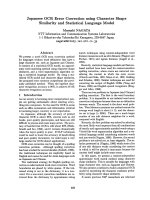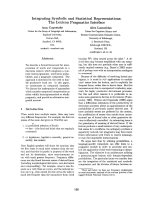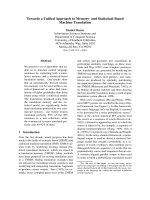Ch2 mathematical and statistical foundations
Bạn đang xem bản rút gọn của tài liệu. Xem và tải ngay bản đầy đủ của tài liệu tại đây (501.04 KB, 60 trang )
Chapter 2
Mathematical and Statistical Foundations
‘Introductory Econometrics for Finance’ © Chris Brooks 2013
1
Functions
• A function is a mapping or relationship between an input or set of inputs
and an output
• We write that y, the output, is a function f of x, the input, or y = f(x)
• y could be a linear function of x where the relationship can be expressed
on a straight line
• Or it could be non-linear where it would be expressed graphically as a
curve
• If the equation is linear, we would write the relationship as
y = a + bx
where y and x are called variables and a and b are parameters
• a is the intercept and b is the slope or gradient
‘Introductory Econometrics for Finance’ © Chris Brooks 2013
2
Straight Lines
• The intercept is the point at which the line crosses the y-axis
• Example: suppose that we were modelling the relationship between a
student’s average mark, y (in percent), and the number of hours studied
per year, x
• Suppose that the relationship can be written as a linear function
y = 25 + 0.05x
• The intercept, a, is 25 and the slope, b, is 0.05
• This means that with no study (x=0), the student could expect to earn a
mark of 25%
• For every hour of study, the grade would on average improve by 0.05%,
so another 100 hours of study would lead to a 5% increase in the mark
‘Introductory Econometrics for Finance’ © Chris Brooks 2013
3
Plot of Hours Studied Against Mark Obtained
‘Introductory Econometrics for Finance’ © Chris Brooks 2013
4
Straight Lines
• In the graph above, the slope is positive
– i.e. the line slopes upwards from left to right
• But in other examples the gradient could be zero or negative
• For a straight line the slope is constant – i.e. the same along the whole line
• In general, we can calculate the slope of a straight line by taking any two
points on the line and dividing the change in y by the change in x
• ∆ (Delta) denotes the change in a variable
• For example, take two points x=100, y=30 and x=1000, y=75
• We can write these using coordinate notation (x,y) as (100,30) and
(1000,75)
• We would calculate the slope as
‘Introductory Econometrics for Finance’ © Chris Brooks 2013
5
Roots
• The point at which a line crosses the x-axis is known as the root
• A straight line will have one root (except for a horizontal line such as y=4
which has no roots)
• To find the root of an equation set y to zero and rearrange
0 = 25 + 0.05x
• So the root is x = −500
• In this case it does not have a sensible interpretation: the number of hours
of study required to obtain a mark of zero!
‘Introductory Econometrics for Finance’ © Chris Brooks 2013
6
Quadratic Functions
• A linear function is often not sufficiently flexible to accurately describe
the relationship between two series
• We could use a quadratic function instead. We would write it as
y = a + bx + cx2
where a, b, c are the parameters that describe the shape of the function
• Quadratics have an additional parameter compared with linear functions
• The linear function is a special case of a quadratic where c=0
• a still represents where the function crosses the y-axis
• As x becomes very large, the x2 term will come to dominate
• Thus if c is positive, the function will be ∪-shaped, while if c is negative it
will be ∩-shaped.
‘Introductory Econometrics for Finance’ © Chris Brooks 2013
7
The Roots of Quadratic Functions
• A quadratic equation has two roots
• The roots may be distinct (i.e., different from one another), or they may
be the same (repeated roots); they may be real numbers (e.g., 1.7, -2.357,
4, etc.) or what are known as complex numbers
• The roots can be obtained either by factorising the equation (contracting it
into parentheses), by ‘completing the square’, or by using the formula:
‘Introductory Econometrics for Finance’ © Chris Brooks 2013
8
The Roots of Quadratic Functions (Cont’d)
• If b2 > 4ac, the function will have two unique roots and it will cross the xaxis in two separate places
• If b2 = 4ac, the function will have two equal roots and it will only cross
the x-axis in one place
• If b2 < 4ac, the function will have no real roots (only complex roots), it
will not cross the x-axis at all and thus the function will always be above
the x-axis.
‘Introductory Econometrics for Finance’ © Chris Brooks 2013
9
Calculating the Roots of Quadratics - Examples
Determine the roots of the following quadratic equations:
1.
2.
3.
4.
y = x2 + x − 6
y = 9x2 + 6x + 1
y = x2 − 3x + 1
y = x2 − 4x
‘Introductory Econometrics for Finance’ © Chris Brooks 2013
10
Calculating the Roots of Quadratics - Solutions
• We solve these equations by setting them in turn to zero
• We could use the quadratic formula in each case, although it is usually
quicker to determine first whether they factorise
1.
x2 + x − 6 = 0 factorises to (x − 2)(x + 3) = 0 and thus the roots are 2 and
−3, which are the values of x that set the function to zero. In other words,
the function will cross the x-axis at x = 2 and x = −3
2.
9x2 + 6x + 1 = 0 factorises to (3x + 1)(3x + 1) = 0 and thus the roots are
−1/3 and −1/3. This is known as repeated roots – since this is a quadratic
equation there will always be two roots but in this case they are both the
same.
‘Introductory Econometrics for Finance’ © Chris Brooks 2013
11
Calculating the Roots of Quadratics – Solutions Cont’d
3. x2 − 3x + 1 = 0 does not factorise and so the formula must be used
with a = 1, b = −3, c = 1 and the roots are 0.38 and 2.62 to two decimal
places
4. x2 − 4x = 0 factorises to x(x − 4) = 0 and so the roots are 0 and 4.
• All of these equations have two real roots
• But if we had an equation such as y = 3x2 − 2x + 4, this would not
factorise and would have complex roots since b2 − 4ac < 0 in the
quadratic formula.
‘Introductory Econometrics for Finance’ © Chris Brooks 2013
12
Powers of Number or of Variables
• A number or variable raised to a power is simply a way of writing
repeated multiplication
• So for example, raising x to the power 2 means squaring it (i.e., x2 = x ì
x).
ã Raising it to the power 3 means cubing it (x3 = x × x × x), and so on
• The number that we are raising the number or variable to is called the
index, so for x3, the index would be 3
‘Introductory Econometrics for Finance’ © Chris Brooks 2013
13
Manipulating Powers and their Indices
• Any number or variable raised to the power one is simply that number or
variable, e.g., 31 = 3, x1 = x, and so on
• Any number or variable raised to the power zero is one, e.g., 50 = 1, x0 =
1, etc., except that 00 is not defined (i.e., it does not exist)
• If the index is a negative number, this means that we divide one by that
number – for example, x−3 = 1/(x3) = 1/(xìxìx )
ã If we want to multiply together a given number raised to more than one
power, we would add the corresponding indices together for example,
ã x2 ì x3 = x2x3 = x2+3 = x5
• If we want to calculate the power of a variable raised to a power (i.e., the
power of a power), we would multiply the indices together – for example,
(x2)3 = x2×3 = x6
‘Introductory Econometrics for Finance’ © Chris Brooks 2013
14
Manipulating Powers and their Indices (Cont’d)
• If we want to divide a variable raised to a power by the same variable
raised to another power, we subtract the second index from the first – for
example, x3 / x2 = x3−2 = x
• If we want to divide a variable raised to a power by a different variable
raised to the same power, the following result applies: (x / y)n = xn / yn
• The power of a product is equal to each component raised to that power –
for example, (x × y)3 = x3 ì y3
ã The indices for powers do not have to be integers, so x1/2 is the notation
we would use for taking the square root of x, sometimes written √x
• Other, non-integer powers are also possible, but are harder to calculate by
hand (e.g. x0:76, x−0:27, etc.)
• In general, x1/n = n√x
‘Introductory Econometrics for Finance’ © Chris Brooks 2013
15
The Exponential Function, e
• It is sometimes the case that the relationship between two variables is best
described by an exponential function
• For example, when a variable grows (or reduces) at a rate in proportion to
its current value, we would write y = ex
• e is a simply number: 2.71828. . .
• It is also useful for capturing the increase in value of an amount of money
that is subject to compound interest
• The exponential function can never be negative, so when x is negative, y is
close to zero but positive
• It crosses the y-axis at one and the slope increases at an increasing rate
from left to right.
‘Introductory Econometrics for Finance’ © Chris Brooks 2013
16
A Plot of the Exponential Function
‘Introductory Econometrics for Finance’ © Chris Brooks 2013
17
Logarithms
• Logarithms were invented to simplify cumbersome calculations, since
exponents can then be added or subtracted, which is easier than
multiplying or dividing the original numbers
• There are at least three reasons why log transforms may be useful.
1.
2.
3.
Taking a logarithm can often help to rescale the data so that their variance is
more constant, which overcomes a common statistical problem known as
heteroscedasticity.
Logarithmic transforms can help to make a positively skewed distribution
closer to a normal distribution.
Taking logarithms can also be a way to make a non-linear, multiplicative
relationship between variables into a linear, additive one.
‘Introductory Econometrics for Finance’ © Chris Brooks 2013
18
How do Logs Work?
• Consider the power relationship 23 = 8
• Using logarithms, we would write this as log28 = 3, or ‘the log to the base
2 of 8 is 3’
• Hence we could say that a logarithm is defined as the power to which the
base must be raised to obtain the given number
• More generally, if ab = c, then we can also write logac = b
• If we plot a log function, y = log(x), it would cross the x-axis at one – see
the following slide
• It can be seen that as x increases, y increases at a slower rate, which is the
opposite to an exponential function where y increases at a faster rate as x
increases.
‘Introductory Econometrics for Finance’ © Chris Brooks 2013
19
A Graph of a Log Function
‘Introductory Econometrics for Finance’ © Chris Brooks 2013
20
How do Logs Work?
• Natural logarithms, also known as logs to base e, are more commonly
used and more useful mathematically than logs to any other base
• A log to base e is known as a natural or Naperian logarithm, denoted
interchangeably by ln(y) or log(y)
• Taking a natural logarithm is the inverse of a taking an exponential, so
sometimes the exponential function is called the antilog
• The log of a number less than one will be negative, e.g. ln(0.5) ≈ −0.69
• We cannot take the log of a negative number
– So ln(−0.6), for example, does not exist.
‘Introductory Econometrics for Finance’ © Chris Brooks 2013
21
The Laws of Logs
For variables x and y:
•
•
•
•
•
•
ln (x y) = ln (x) + ln (y)
ln (x/y) = ln (x) − ln (y)
ln (yc) = c ln (y)
ln (1) = 0
ln (1/y) = ln (1) − ln (y) = −ln (y)
ln(ex) = eln(x) = x
‘Introductory Econometrics for Finance’ © Chris Brooks 2013
22
Sigma Notation
• If we wish to add together several numbers (or observations from
variables), the sigma or summation operator can be very useful
• Σ means ‘add up all of the following elements.’ For example, Σ(1 + 2 + 3)
=6
• In the context of adding the observations on a variable, it is helpful to add
‘limits’ to the summation
• For instance, we might write
where the i subscript is an index, 1 is the lower limit and 4 is the upper
limit of the sum
• This would mean adding all of the values of x from x1 to x4.
‘Introductory Econometrics for Finance’ © Chris Brooks 2013
23
Properties of the Sigma Operator
ã
ã
ã
ã
Introductory Econometrics for Finance â Chris Brooks 2013
24
Pi Notation
• Similar to the use of sigma to denote sums, the pi operator (Π) is used to
denote repeated multiplications.
• For example
means ‘multiply together all of the xi for each value of i between the lower
and upper limits.’
• It also follows that
‘Introductory Econometrics for Finance’ © Chris Brooks 2013
25









